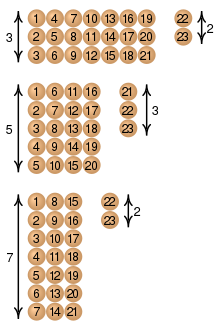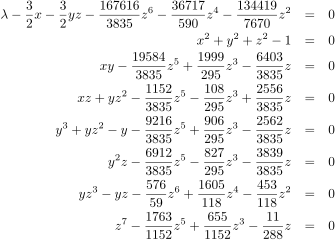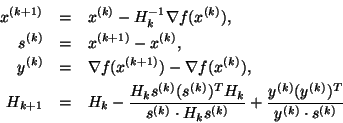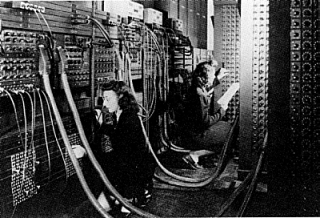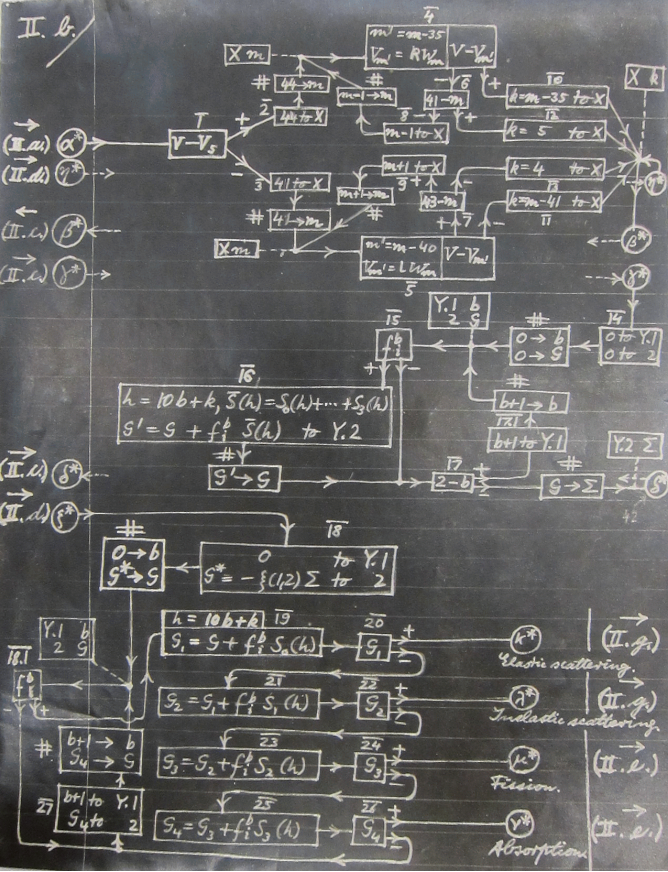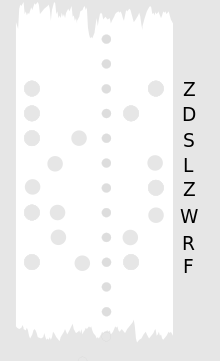MATH661
Scientific Computing
I |
|
Summary. An introduction to scientific computing theory
and practice covering approximation of numbers, real functions,
functionals, and operators. A presentation of classical numerical
methods topics, but with a focus on how key unifying ideas naturally
lead from Newtonian interpolation to deep neural networks. A literate
programming and reproducible computation approach is utilized using the
Julia language within live TeXmacs documents
that allows simultaneous presentation of theory and implementation, as
well as reproducible computational experiments, trying to adhere as much
as possible to the adage:
“Beauty is truth, truth beauty, – that is all
Ye know on earth, and all ye need to know.”
John Keats, Ode on a Grecian Urn.
Course syllabus
Times
|
MoWe 10:10AM-11:25PM, Phillips 228
|
Office hours
|
MoWe 2:00PM-3:30PM, Tu 12:00-1:30PM Chapman 451, and by email
appointment
|
Instructor
|
Sorin Mitran
|
| Assistant |
Emma Crawford (Office hours: We
9:00-10:00AM, Fr 11:30AM-12:30PM) |
| Jump to |
Tracks: 2.2 Lessons: 3.2Homework: 3.3Software:
4.2Live documents: 4.5 |
(The instructor reserves the right to make changes to the syllabus.
Any changes will be announced as early as possible.)
1Introduction
1.1Historical overview
Scientific computing encompasses a vast range of techniques and
applications ranging from discrete computations on graphs describing
social networks to stochastic molecular dynamics of protein folding.
Mathematical topics that arise range from group theory and use of the Chinese Remainder Theorem to construct factorizations, to Gröbner bases to solve polynomial systems,
or combining optimization theory with analysis to solve
non-linear systems through a quasi-Newton method (Fig. 1).
|
|
Figure 1. Left: Schematic of
Chinese Remainder Theorem. Center: Gröbner basis
transformation of the system ,
,
,
is actually easier to solve than the initial formulation since
the last equation is only in .
Right: Broyden-Fletcher-Goldfarb-Shanno algorithm
to solve an optimization problem by including curvature
information into a gradient descent procedure.
|
A comparably large toolkit of software applications has been developed
since the first general purpose digital computer (ENIAC
– Electronic Numerical Integrator and Computer) capable of about
500 FLOPS (floating point operations per second) was
introduced. ENIAC was initially “programmed” by physically
linking certain wires between functional units according to a flow-chart
Fig. 2, a time-consuming and tedious process that was soon
replaced by “coding”, the practice of
specifying a sequence of logic operations to control the machine, an
idea that predates ENIAC, and introduced through the
assembly language of the Mark I computer input to the
machine through a punched paper tape Fig. 2. This approach
was still being used when your current instructor was in high school in
the 1970's working on a electromechanical teleprinter,
though the programming language had fortunately evolved to the more
palatable BASIC language.
|
|
Figure 2. Left: Programming ENIAC
by connecting wires to different functional units. Center:
Flowchart guiding the wire connections. Left: Part of a punched
paper tape program.
|
1.2Course goals
It is apparent that a single course can only provide an introduction to
the myriad developments within scientific computing from the past eight
decades. The main goals of this course is to explore how a few key ideas
can be applied to representative problems encountered in scientific
computation.
1.2.1Mathematics
There are just four mathematics ideas that are considered in this
course:
-
Approximation
-
The notion of replacing some complicated mathematical object by
one that is simpler to compute. In succession, the course
presents the approximation of numbers, functions, and operators.
The main focus is on numerical approximation, but computational
analytical approximation is also presented.
-
Linear combination
-
An approach to constructing complex objects by scaling and
addition of simpler objects. Note the link to approximation, in
that “simpler to compute” is interpreted as scaling
and addition.
-
Nonlinear combination
-
An approach to constructing complex objects by function
composition, successive nonlinear transformation of simpler
objects.
-
Limits
-
An approach to constructing complex objects by a sequence of
approximations.
The above ideas have the character of a leitmotif
in a Wagner opera: a salient feature that constantly makes its
appearance throughout a work. Irrespective of the particular field of
scientific computing you choose to pursue, the above ideas obstinately
recur.
1.2.2Computing
Comparable simplicity is encountered in computational ideas. Even though
human passion can lead to “programming language
wars”, key computational concepts are few in number:
-
Memory management
-
Transfer and organization of data on a computer.
-
Repetition
-
Multiple execution of a task. Two repetition types are
encountered:
-
Iteration
-
A portion of code that is repeatedly executed, typically
within a loop.
-
Recursion
-
A portion of code organized as a function that calls
itself.
We shall present the close correspondence between the computer
science concepts of iteration and recursion to the mathematical
concepts of linear and nonlinear combination, respectively.
-
Condition testing
-
Carrying out decisions based on data.
The above basic concepts have been embodied into dozens of computer
languages (e.g., FORTRAN, LISP, BASIC,
Pascal, ALGOL, Ada, C,
C++, MATLAB, Perl, Python),
with useful features from each often appearing in subsequent revisions
of others (e.g., Fortran 2018 contains many features from C++ and
MATLAB). In practice, a sound understanding of one language is
sufficient to quickly pick up another.
This course adopts the Julia programming language, a
general-purpose language that incorporates many prior ideas found useful
for scientific computing.
1.2.3Scholarship
Relevance of computational approaches to science requires adoption of
the scientific method of verification of the predictions resulting from
conjectures (or hypotheses or theories). For scientific computing, the
conjectures are the mathematical approach and implementation into a
program executed by a computer. Predictions are obtained from program
execution and verified by comparison to known results or experiments.
Such computational predictions should be reproducible.
A key part of the scientific method is documentation of an
investigation, clearly citing sources, approaches, hypotheses, and
results. An important goal of this course is to instill this practice of
scholarship into all aspects of scientific computing. As the case of
general-purpose languages, several specialized programming languages
have been developed for this purpose (TeX, LaTeX,
Markdown), some with an explicit focus on documenting
theoretical approach and computer implementation simultaneously (Web), a practice known as literate programming.
This graduate course utilizes a literate programming approach based upon
the TeXmacs platform in conjunction with Zotero
reference management. While the focus of undergraduate education is to
accumulate knowledge and optionally be exposed to research, that of
graduate education is to acquire the skill set needed to carry out new
original research. To aid in this transition, course tasks are organized
as steps in the production of a research paper. Supplementing the
presentation of course topics in TeXmacs, sample
documentation and Julia implementations are also provided in the Pluto environment.
1.3Course outcomes
Upon successful course completion students will be:
-
able to recognize particular types of approximation;
-
proficient in the basic operations of numerical linear algebra;
-
able to determine the computational complexity of an algorithm;
-
capable of recognizing mathematical problems that are inherently
difficult to compute (e.g., “ill-conditioned”), and
estimating the error arising from numerical approximation;
-
exposed to computational analytical approximations, and capable of
comparing numerical and analytical approximations to verify
algorithm performance;
-
introduced to both traditional additive approximations based upon
linear combination and the burgeoning field of approximations
based upon function composition inspired by brain functionality
(neural networks).
2Course information
2.1Honor code
Unless explicitly stated otherwise, all work is individual. You may
discuss various approaches to homework problems with students,
instructors, but must draft your answers by yourself. All external
sources consulted must be acknowledged and cited. Students implicitly
accept this honor code by submission of any work for grading.
2.2Course policies
-
Class attendance is expected and essential for understanding of
course topics. There is no need to inform instructor of planned
absences. Office hour attendance is recorded and required at a
minimum of one half-hour every two weeks. Self-organize into teams
of two or three students and prepare questions prior to office
hours. Be prepared to be quizzed on definitions during office
hours. Come prepared with: notes, laptops, well-formulated
questions. Students not prepared for office hours will be invited
to come at a later date.
-
Course grade is based upon accumulation of credit points (0-100).
There is no “grading on a curve”. Extra credit
opportunities are offered for an additional 12 grade points, to
allow for missed homework or tests.
-
Homework is to be submitted in typeset form (TeXmacs preferred,
Pluto notebook accepted) electronically through Canvas.
Handwritten homework is not accepted. The assignment deadlines are
strictly enforced. Late homework is accepted only in the case of
University approved class absences. E-mail messages
requesting acceptance of late homework due to any other
circumstance are deleted without review or response. Students are
advised to prepare and submit homework well in advance of the
Canvas deadline to allow for unforseen difficulties. Suspension of
classes due to campus-wide events (weather, pandemic, etc.) will
lead to modification of due dates or elimination of specific
assignments for the entire class.
-
Two different tracks are offered for users and developers of
scientific computation. The same theory is covered, but
assignments differ between the two tracks. Both tracks are
presented at the graduate level of study.
-
Scientific computation users. Students interested in
applying existing computational techniques. Typically, most
undergraduates and many non-mathematics graduates are within
this group. The emphasis of the coursework is on understanding
theoretical approaches and practical aspects of computing.
Coursework requires only material presented in class notes.
-
Scientific computation developers. Students
interested in extending existing computational techniques or
devising new approaches. Mathematics graduate students
must follow this track. Other students expecting to
apply computational methods during their careers should also
follow this track. This track is also available on an
assignment by assignment basis to any student wishing to
explore development of advanced computational methods. The
emphasis of the coursework is theoretical analysis, novel
algorithm formulation, and carrying out algorithm validation.
Comparison of course material to alternative sources is
required.
Accessibility resources and services. The University of North
Carolina at Chapel Hill facilitates the implementation of reasonable
accommodations, including resources and services, for students with
disabilities, chronic medical conditions, a temporary disability or
pregnancy complications resulting in barriers to fully accessing
University courses, programs and activities.
Accommodations are determined through the Office of Accessibility
Resources and Service (ARS) for individuals with documented qualifying
disabilities in accordance with applicable state and federal laws. See
the ARS Website for contact information: https://ars.unc.edu
or email ars@unc.edu.
Counseling and psychological services (CAPS). CAPS is strongly
committed to addressing the mental health needs of a diverse student
body through timely access to consultation and connection to clinically
appropriate services, whether for short or long-term needs. Go to their
website: https://caps.unc.edu/ or visit their facilities on
the third floor of the Campus Health Services building for a walk-in
evaluation to learn more.
Title IX resources. Any student who is impacted by
discrimination, harassment, interpersonal (relationship) violence,
sexual violence, sexual exploitation, or stalking is encouraged to seek
resources on campus or in the community. Reports can be made online to
the EOC at https://eoc.unc.edu/report-an-incident/. Please
contact the University's Title IX Coordinator (Elizabeth Hall, interim
– titleixcoordinator@unc.edu), Report and Response
Coordinators in the Equal Opportunity and Compliance Office (reportandresponse@unc.edu),
Counseling and Psychological Services (confidential), or the Gender
Violence Services Coordinators (gvsc@unc.edu; confidential)
to discuss your specific needs. Additional resources are available at safe.unc.edu.
2.3Grading
Coursework involves multiple activities, differentiated between user and
developer tracks.
-
Homework aids assimilation of basic course concepts through
small-scale applications:
10 assignments 4 points = 40
points.
Eleven assignments are given allowing students to miss one
homework due to personal reasons or to use as extra credit. HW00
is meant to familiarize students with the homework drafting
process and expectations, and though not graded is returned with
comments that must be respected in future assignment submissions.
-
Projects explore medium-scale applications and scholarly
practices:
2 projects 8 points = 16 points.
-
Office hour participation: 8 visits
0.5 point = 4 points.
-
Midterm examination 1 (in-class, 60 minutes) in Week 6 on linear
algebra: 10 points.
-
Midterm examination 2 (in-class, 60 minutes) in Week 10 on real
function approximation: 10 points.
-
Final examination covering all course material scheduled
at 8:00AM on Th, Dec. 14, 2023: 20 points.
-
Extra credit on supplementary topics: 2 topics
4 points = 8 points.
-
All coursework is graded at the graduate level. Undergraduate
students are allocated an initial 20 course points to reward
participation in an advanced course.
Mapping of point scores to letter grades
Grade
|
Points
|
Grade
|
Points
|
Grade
|
Points
|
Grade
|
Points
|
H++, A+
|
101-112
|
H-, B+
|
86-90
|
P-, C+
|
71-75
|
L-, D+
|
56-60
|
H+, A
|
96-100
|
P+, B
|
81-85
|
L+, C
|
66-70
|
L-, D
|
50-55
|
H, A-
|
91-95
|
P, B-
|
76-80
|
L, C-
|
61-65
|
F
|
0-49
|
A passing score can be obtained solely through homework, projects and
office hour participation (60 points, L-/D+ grade). Undergraduate
students who participate in office hours and correctly complete homework
and projects attain 80 points (B- grade), with additional points
available from examinations and extra credit. Latin honors are used for
A+, H+, H++ grades, i.e., H++ (112 points) is entered as H with a
transcript annotation of summa cum laude, at instructor's
discretion.
3Lesson plan
3.1Course modules
Though unitary in nature, the course is organized in distinct modules
that may be useful for auditors from diverse backgrounds not interested
in taking the full course.
Module
|
Topics
|
Number approximation
|
Computational representations of
|
Numerical linear algebra
|
Introduction to approximation by linear combination.
|
Real function approximation
|
Approximation of functions
|
Linear operator approximation
|
Approximation of linear functions defined on a vector space , i.e., scalar-valued linear functionals
,
and vector-valued linear operators .
|
Nonlinear operator approximation
|
Approximation of non-linear functionals and operators.
|
3.2Course topics, test dates, and notes
Midterm dates are indicated in bold
red.
Lesson Schedule
Week
|
Notes
|
Exercises
|
Date
|
Topic
|
01
|
|
|
|
Floating point arithmetic. Approximating sequences. Order of
convergence. Finite difference approximation of derivative and
catastrophic loss of precision. Condition number.
|
02
|
|
E03
|
|
Linear combinations. Vector and matrix norms. Linear functionals and
mappings. Vector spaces and subspaces. Bases. Dimension. Orthogonal
matrices. Matrix subspaces.
|
03
|
|
|
|
Bases. Dimension. Orthogonal matrices. Matrix subspaces.
Fundamental theorem of linear algebra. Rank-nullity.
|
04
|
|
E04
|
09/13
|
Singular value decomposition theorem & proof.
Karhunen-Loève. Rank-1 expansions. Operator approximation.
Linear statement of applied mathematics problems: coordinate changes
(linear systems), reduced-order models (least squares), operator
invariants (eigenproblems). SVD solutions. Pseudo-inverse.
|
05
|
|
|
|
least-squares solution. Additional operator representations: ,
,
,
.
Computational complexity. Projection: Householder, Givens.
Eigenvalue algorithms, Rayleigh iteration.
|
06
|
|
|
09/27
|
Midterm examination 1 on linear algebra topics.
|
07
|
|
|
|
Approximation in the monomial basis. Interpolation. Newton, Lagrange
forms. Taylor series. Polynomial interpolation error.
|
08
|
|
|
|
Hermite interpolation. Splines. -spline
basis. Finite elements.
|
09
|
|
|
|
Approximation in spectral bases. Fourier, Wavelet approximations.
approximants. Minimax.
|
10
|
|
|
10/23
10/25
|
Midterm examination 2 on real function approximation.
|
11
|
|
E07
|
|
Linear operator approximation 1: quadrature ().
Newton-Cotes. Moments. Gauss quadrature. Convergence. Romberg.
Linear operator approximation 2: differentiation ().
|
12
|
|
|
|
Linear ODE ().
Convergence. Stability
|
13
|
|
|
|
Non-linear operator approximation 1:
0,1,2-degree approximants (secant, Newton, Steffensen, Halley,
Householder). Convergence, fixed points.
|
14
|
|
|
|
Non-linear operator approximation 2: .
0,1,2-degree approximants. Convexity, steepest descent. Stochastic
steepest descent.
|
15
|
|
|
|
Non-linear operator approximation 3: .
Quasi-Newton methods.
|
16
|
|
|
12/04
12/06
|
Non-linear combinations. Neural networks. Neural network
approximation of real scalar functions, real functionals, real
vector functions. Neural network approximation of operators.
|
3.3Homework and Projects
Nr.
|
Topic
|
Issue Date
|
Due Date
|
Problems
|
Solution
|
HW00
|
Number approximation
|
08/23
|
09/06
|
H00
|
S00
|
HW01
|
Numerical linear algebra
|
|
|
|
|
HW02
|
|
09/06
|
09/13
|
H02
|
S02
|
HW03
|
|
09/13
|
09/20
|
H03
|
S03
|
HW04
|
|
09/20
|
09/27
|
H04
|
S04
|
P01
|
|
10/02
|
10/16,11/20
|
P01
|
|
HW05
|
|
10/04
|
10/11
|
H05
|
S05
|
HW06
|
Real function approximation
|
10/11
|
10/18
|
H06
|
S06
|
HW07
|
|
10/16
|
10/23
|
H07
|
S07
|
EC
|
|
10/25
|
11/08
|
EC
|
|
HW08
|
Linear operator approximation
|
10/25
|
11/06
|
H08
|
S08
|
HW09
|
|
11/13
|
11/20
|
H09
|
S09
|
P02
|
|
11/15
|
11/27
|
P02
|
|
HW10
|
Nonlinear operator approximation
|
11/27
|
12/06
|
H10
|
S10
|
HW11
|
|
11/29
|
12/06
|
H11
|
S11
|
3.4Test preparation and solutions
3.5Extra credit topics
For each of the topics below:
-
read the relevant class notes or indicated textbook presentation
-
look up and read original sources
-
try a small sample computation
-
present influence of work in the field by following citations of
original sources
Nr.
|
Issue Date
|
Due Date
|
Topic
|
01
|
09/27
|
10/23
|
Linear model reduction
|
02
|
10/23
|
12/04
|
Fractional derivative approximation
|
3.6Bibliography
Course textbook: Scientific Computation by S.
Mitran.
Perusal of the following texts is highly recommended for all, and is
required for Track 2 students who can expect to be quizzed on
topics from these texts during office hour visits.
Numerical Linear Algebra, by L.N.
Trefethen and D. Bau.
Matrix Computations, by G.H. Golub
and C.F. Van Loan
Applied Numerical Linear Algebra, by J.W.
Demmel
Matrix Iterative Analysis, by R.S.
Varga
Methods of Mathematical Physics, by R.
Courant and D. Hilbert
Methods of Theoretical Physics, by P.M. Morse and
H. Feshbach
Mathematics for the Physical Sciences, by L.
Schwartz
Computational Functional Analysis, by R. Moore
4Computational resources
4.1Hardware
Students are required to have a computer, preferably a laptop, that
conforms to CCI minimal standards. Current computers use
either a CISC (complex instruction set computer) or RISC (reduced
instruction set computer) architecture. A recommended
laptop based on the CISC Intel x86-64 architecture would be equipped
with a 6-core processor, 4 GB NVIDIA GPU, 16GB RAM, 512 GB SSD or
better. A recommended laptop based on the Apple arm64 RISC
architecture would be equipped with an 8-core processor, 16GB unified
RAM, 512 GB SSD or better. The course will explore algorithm parallelism
both on multi-core CPUs and on GPUs, and algorithm verification will
often require consideration of larger problems.
4.2Software
Modern software systems allow efficient, productive formulation and
solution of mathematical models. A key goal of the course is to
familiarize students with these capabilities and acquire the practical
skills needed for scientific computing. Three software approaches are
possible:
-
Preconfigured virtual machine
-
This is the preferred and fully supported option. On
machines with the x86-64 architecture, install the SciComp@UNC
environment in which tools required for modern scientific
computation have been preconfigured for immediate use. Follow
instructions at SciComp@UNC to install on a laptop
with at least 24GB free disk space and 8GB RAM.
-
Individual software package installation
-
For students comfortable in system administration. Limited
support only for arm64 architecture. On machines with
either x86-64 or arm64 architecture, install the main software
packages used in the course.
Windows OS.
-
Create a directory named C:\courses
-
Install TortoiseSVN
-
Open File Explorer and right-click to open options
(“See more options” in Windows 11) for folder
C:\courses. Select SVN checkout option and
enter:
URL repository: svn://mitran-lab.amath.unc.edu/courses/MATH661
Checkout directory: C:\courses\MATH661
Click OK, and a copy of the course material repository is
downloaded to your laptop.
-
Julia programming language. Choose installation
directory C:\courses\julia
Modify the System variable PATH to include C:\courses\julia\bin
In Julia terminal session install the Printf, Latexify,
PyPlot, LinearAlgebra, Revise packages. Add the path to the
julia executable to your system PATH
variable. For example, to install Latexify within a Julia
session:
-
TeXmacs editing platform. Choose installation
directory C:\courses\texmacs
-
Zotero reference management system.
-
Open File Explorer and right-click to open options
(“See more options in Windows 11”) for folder
C:\courses\texmacs\plugins. Select SVN
checkout option and enter:
URL repository:
svn://mitran-lab.amath.unc.edu/courses/texmacs/plugins/julia
Checkout directory: C:\courses\texmacs\plugins\julia
Mac OS.
-
Open the Terminal app and create a directory named ~/courses
cd ~; mkdir courses
-
Install SmartSVN
-
Open SmartSVN and select option Check out project from
repository, click OK. Enter:
Repository: svn://mitran-lab.amath.unc.edu/courses/MATH661,
select MATH661 directory
Local directory: ~/courses/MATH661
Click Continue, and a copy of the course material repository
is downloaded to your laptop.
-
Julia programming language. Choose installation
directory C:\courses\julia
Modify the System variable PATH to include /Applications/Julia-1.6.app/Contents/Resources/julia/bin
In Julia terminal session install the Printf, Latexify,
PyPlot, LinearAlgebra packages. Add the path to the julia executable to your system PATH variable.
For example, to install Latexify within a Julia session:
-
TeXmacs editing platform.
-
Zotero reference management system.
-
Open SmartSVN and select option Check out project from
repository, click OK. Enter:
Repository:
svn://mitran-lab.amath.unc.edu/courses/texmacs/plugins/julia
Checkout directory: /Applications/TeXmacs.app/Contents/Resources/share/TeXmacs/plugins
Students are responsible for software configuration. Help will
be given through posted instructions within available time.
Since the course focuses on the mathematics of scientific
computing, e-mail or office hour support for this software
option is not possible, and such requests will uniformly be
answered by the suggestion to install the preconfigured SciComp@UNC
environment.
4.3Tutorials
Software usage is introduced gradually in each class, so the first
resource students should use is careful, active reading of the material
posted in class. In particular, carry out small tasks until it becomes
clear what the software commands accomplish. Some additional resources:
4.4Course material repository
Course materials are stored in a repository that is accessed through the
subversion utility, available on all major operating systems. The URL of
the material is svn://mitran-lab.amath.unc.edu/courses/MATH661
In the SciComp@UNC virtual machine the initial checkout can be carried
out through the terminal commands
Update the course materials before each lecture by:
Links to course materials will also be posted to this site, but the most
up-to-date version is that from the subversion repository, so carry out
the svn update procedure prior to each lecture.
4.5Interactive documents
All course material is presented as TeXmacs documents with embedded
interactive Julia sessions. Such documents have a .tm
extension and are available through svn download from the course
repository. Notes posted on the lesson plan contain translations of the
live documents to .pdf formats.
Live documents allow immediate application of course topics, shown here
for the simple case of a bisection method to solve the equation ,
when , and .
The algorithm constructs sequences ,
that bracket the root , with the root
approximation at iteration given by to within a
maximum absolute error of .
Algorithm - Bisection method
|
Julia (1.6.1) session in GNU TeXmacs
∴ |
function bisect(f,a,b,ε)
if (a>b) a,b=b,a end
fa=f(a); fb=f(b)
δ=b-a; c=(a+b)/2
while ((δ>ε) && (fa*fb<=0))
δ=δ/2; c=a+δ; fc=f(c)
if (fa*fc<=0)
b,fb=c,fc
else
a,fa=c,fc
end
end
return c
end; |
∴ |
f(x)=x^2-2; a=1; b=2; ε=0.01; |
∴ |
[bisect(f,a,b,ε) sqrt(2.0)] |
|
(1) |
∴ |
g(x)=x^2-3; a=1; b=2; ε=0.001; |
∴ |
[bisect(g,a,b,ε) sqrt(3.0)] |
|
(2) |
|
Pluto has an analogous approach, but with fewer capabilities, e.g., the
table organization shown above that allows immediate transcription of
the pseudocode for the bisection method into Julia. More importantly,
TeXmacs is an efficient medium for prototyping ideas and subsequently
transforming them into formal scientific communication, i.e., research
papers.
